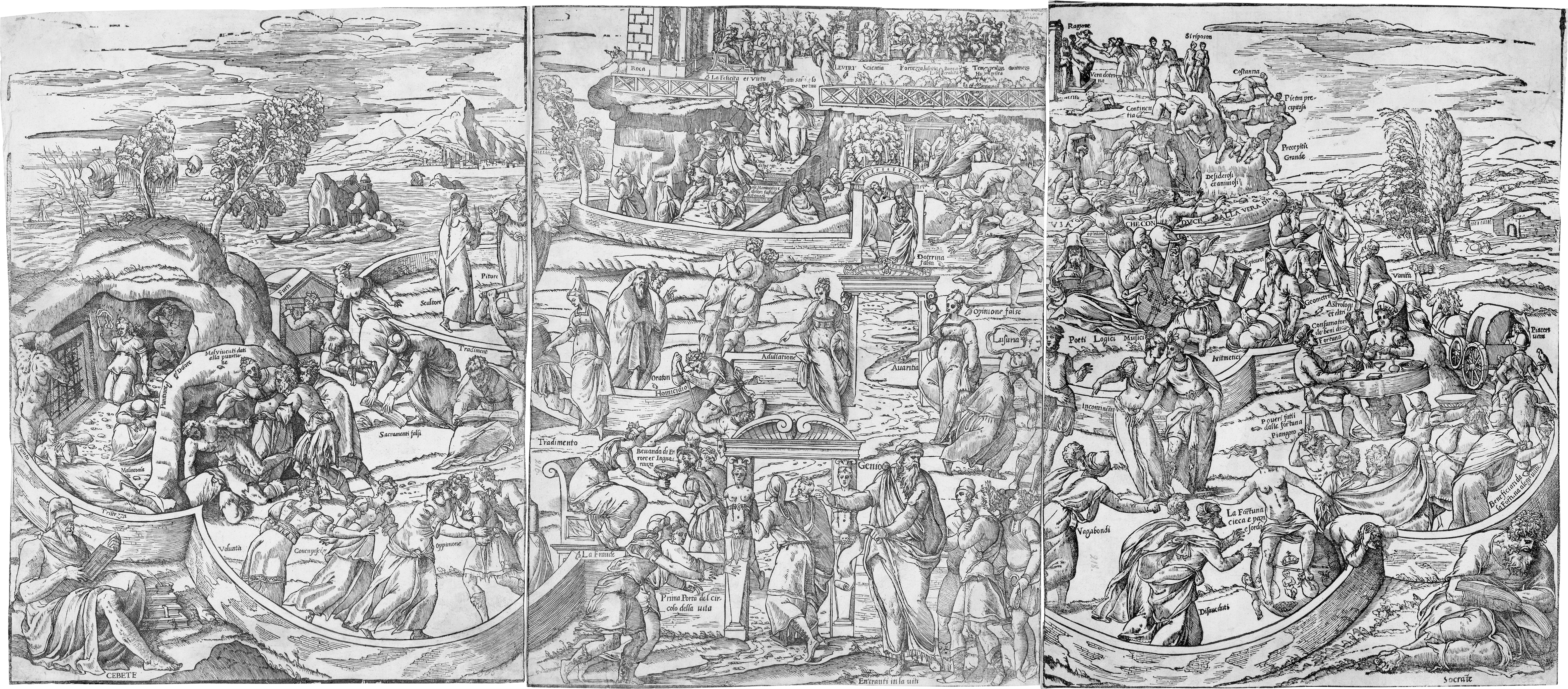Loading the page ...
Venetian School
(circa 1550)
Tabula Cebetis. Woodcut from three plates, printed on three sheets.
51 x 39.4 cm, 52 x 39.2 cm and 52.5 x 39.5 cm. Passavant VI, 6, p. 239, no. 80; Nagler, Neues allgemeines Künstler-Lexicon, vol. 20, p. 228, 2 (Vieceri).
The Tabula Cebetis or Tablet of Cebes was a philosophical dialogue written in Greek in late antiquity (first century A.D.), the authorship of which was attributed at a very early stage to Cebes of Thebes (circa 400 B.C.), a pupil of Socrates. In the text an old man outside a temple of Kronos passes comment on an allegorical mural inside on the theme of life’s journey. The dialogue on the subject of ethics, which was rediscovered in Italy in the 15th century, was published in Latin in Bologna in 1497. It was thus the source for the dissemination throughout Europe of numerous modern-language translations and commentaries. The mural, described in the ekphrasis of late antiquity, underwent frequent pictorial reconstruction by artists of the early modern period both in the title engravings of book editions, as exemplified by Holbein the Younger in 1521 (Hollstein 33.b), and in independent depictions with captions and inscriptions, a well-known example of the latter in Northern Europe being the engraving made in 1592 by Jacob Matham (Hollstein 253) after an invention by Hendrick Goltzius.
The Tablet of Cebes was widely distributed in text editions and artistic reproductions as late as the 18th century. The typical structure of these works comprises concentric wall rings with allegorical figures, through which man passes on his journey through life and in the course of his intellectual development. The present woodcut from three plates is an early Italian example of this theme. The two philosophers are sat in opposite corners in the foreground in accordance with the attribution to Socrates’ pupil, Cebes of Thebes. In the centre of the picture an old man (Genio/Daimon) admits a few figures to the first wall ring. He sets them on the right path to happiness but, after entering life, they are immediately given a potion of deception (Fraude/ Apate) which puts them on the wrong track. The first ring is the home of the senses, of material things, where Fortune (Tyche), who is both deaf and blind, sits on the right and a number of protagonists are already moving off in the wrong direction, while on the left evil deeds are committed and punishments meted out. The second wall ring is the home of the intellect; here false erudition and the arts can divert people from the path of true education. The vera dottrina can only be reached via a steep climb (top right); here new arrivals are purified with an antidote to the potion of deception and enabled to move on to the third ring and the castle of happiness (top left).
The first Italian translation of the Tabula Cebetis by Franceso Coccio da Iano, printed in Venice in 1538, appears to be the source drawn on by our artist, since the design and inscriptions of the allegories match the vocabulary used in this edition. Hence the year it was published can serve as a terminus post quem.
The present extremely rare depiction of the Tabula Cebetis is closely related in stylistic respects to another version of the subject matter dated 1549 and published in Venice the same year (see R. Schleier, Tabula Cebetis, Berlin 1973, p. 42f., fig. 39). Both sheets are very much in the tradition of large-scale Venetian woodcuts, which had their heyday in the second half of the Cinquecento. The crowded, highly finished composition with its extremely complex and erudite pictorial programme reveals the hand of a practised and experienced artist. Despite the huge format, the depiction has narrative coherence and a convincing visual impact. For a long time there was disagreement over who was the author of our print. Weigel (1840), Nagler (1850) and Passavant (1864) thought the woodcut was based on a drawing by Paolo Veronese. Passavant referred to an impression with the address “In Venetia il Vicceri”. However, it has now been established that this address appeared only on later reprints. Adolph Goldschmidt, on the other hand, associated the woodcut with the Flemish master, Lambert Lombard, and characterised the work, albeit not very convincingly, as “Dutch Italianate”. He thought it might be a reproduction of a grisaille painting by Lombard which was mentioned by the humanist, Dominicus Lampsonius, in his life of the artist. For the time being the authorship of this fascinating, high-quality woodcut remains unresolved. That the author must have been a woodcutter active in Venice around the middle of the 16th century is beyond doubt. The sweeping, evocative landscape background is closely modelled on designs by Titian and Domenico Campagnola, but the way in which the many lively protagonists are drawn provides no further clues to the author. The two philosophers, Socrates and Cebes, are faintly reminiscent of the Mannerist figurative canon of Domenico Beccafumi, although the overall visual impression conforms more to the Venetian aesthetic in the second half of the 16th century.
We know of the existence of two other impressions of the woodcut in the British Museum in London and the Kupferstichkabinett Berlin respectively. The impression in the British Museum, which is blotched and of poor printing quality, has a complex and convoluted monogram which Nagler attributes to an anonymous engraver and publisher, but it appears to be a stamp (Monogrammisten IV, 2693). Very fine, strong impressions, printed verso with a distinct relief. Minor ageing and handling traces, incidental thin patches verso in the corners and the centre, otherwise – in view of the size of the sheet – in excellent condition.
Contact us for further information